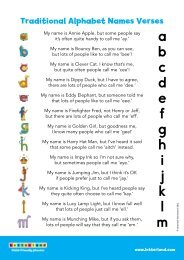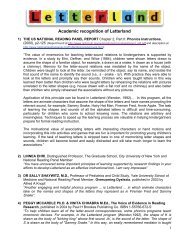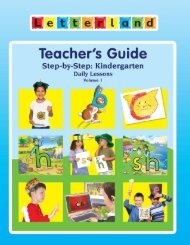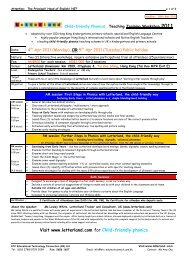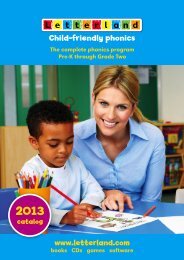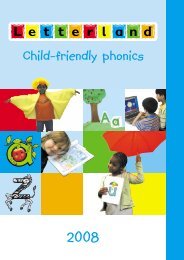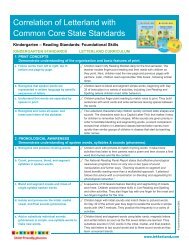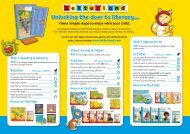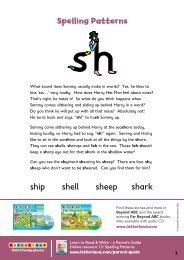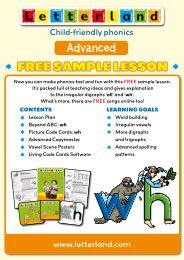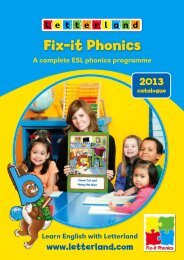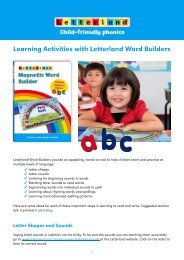Teacher's Guide - Letterland
Teacher's Guide - Letterland
Teacher's Guide - Letterland
You also want an ePaper? Increase the reach of your titles
YUMPU automatically turns print PDFs into web optimized ePapers that Google loves.
© <strong>Letterland</strong> International Limited. All rights reserved.spell the listed words, one per child. Then line upthe children with the letters in the first wordfacing the class holding their PCCs for all to see.• Stand behind the ‘<strong>Letterland</strong>ers’ (the childrenholding the PCCs). They make their lettersounds in sequence as you tap each one’sshoulder.• In this part of the lesson and in a number of otherUnit activities, children use various multisensorystrategies to help them blend words for reading.These strategies include the Rollercoaster(blending sounds as your right hand slides downyour left arm) and Finger Sounding (children usetheir fingers to represent sounds). These methodsare described in detail in the Teaching Strategiessection (Roller-Coaster, p 34; Finger-Sounding,p 34).• Variations To add some variety and to providethe best focus on a particular concept, someUnits may call for you to introduce the newconcepts with Live Reading (usually the nextstep below) or with Live Spelling (usually doneon Day 2).What is the purpose of this activity?• Using the Picture Code Cards on the pocketchart is an excellent way to focus children’sattention on the phonic concept and the phonicfable in a calm, quiet setting. It is a briefintroduction that usually sets the scene for themore active Live Reading activity that follows it.Children have the opportunity to listen carefullyto the new ideas that they will be using the restof the week in reading and spelling activities.Live ReadingMaterials Picture Code Cards listed at thebeginning of the activity, and a Reading Directionsign (Appendix). On occasion props for the<strong>Letterland</strong>ers such as a hat for Harry Hat will belisted (Costumes and Props, Appendix).Procedures• In Live Reading, children get a chance to be the<strong>Letterland</strong>ers. You distribute the PCCs needed toLive Reading• Arrange children holding PCCs toform the word.• The children holding the PCCsmake their sounds in order.• The other children Finger Soundor Rollercoaster blend the word:/r/ /u/ /n/, run.• You or one of the children saythe word in a sentence.• Build the next word.• Next hold your hand over each <strong>Letterland</strong>er asthe class Finger-Sounds the word.• Then sweep your hand above the <strong>Letterland</strong>ers asthe class blends the sounds to make a word. It isa good idea to say a brief sentence with the wordat this point to make sure everyone understandsthe word.• In many lessons, you will then change only oneor two letters by letting other children with PCCsswap places to make the new word.• Children continue to use their multisensoryblending strategies to sound out the words.What is the purpose of this activity?• In Live Reading children use their imaginationsto actively play at the process of making words,changing words, and acting out the ‘phonicfables’ that support their reading and spellingdevelopment.8



